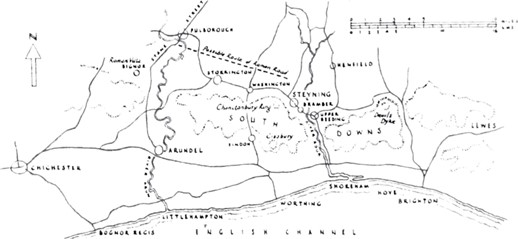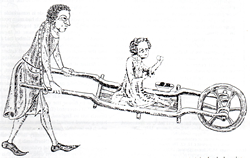
BRIEF HISTORY OF STEYNING
There is no definite evidence that Steyning existed before the Saxon period. It is known that there were settlements of the early Celtic colonists on the Downs before Roman times and that they left Cissbury and other hill forts to seek better and more sheltered valley conditions. We cannot tell whether the Steyning and Bramber area was among those chosen but it is a reasonable assumption.
The River Adur was a wide navigable estuary with sites on its banks which offered the merits of communication by both water and land in addition to numerous other advantages. Spring water was available from the adjacent chalk escarpment and there were dry building sites on the upper greensand, with good arable lowlands and pastures on the Downs. Building materials were in ample supply: timber for building and fuel from the Weald; from the river there was sand and also reeds for thatching; flints were mined from the chalk which also produced lime for mortar. Subsequent river silt may conceal any evidence but was this then the beginning of Steyning?
There is some scanty evidence of Roman occupation but the remains of a road which ran from east to west a mile or two north of the town to join Stane Street, suggests that the Romans had little interest in Steyning for major development.
Following the settlement by the Saxons in the 5th century in the coastal plains, the Sussex Levels, local evidence of Saxon remains in the areas around the church, confirm that In this period the port was developed and the adjacent settlement was expanded into the nucleus of a town. Its accessibility made the town ideal for marketing wool, salt from the estuary and the surplus of its other natural assets such as timber.
From this period, when the new Christian faith had all but overcome the entrenched Saxon pagan religion save for Sussex, arose the legend of St. Cuthman. He was a shepherd boy, a pious youth possessed of divine powers who on the death of his father travelled from the west bearing his ailing mother on a simple cart which broke down on reaching Steyning, where he settled. Here he built a small wooden church on a site which is believed to have been just north of our present Parish church of St. Andrew. Whether legend or fact Cuthman is certainly a name recorded in early history; the church was once St. Cuthman’s and the port was Portus Cuthmanni. As for the name of Steyning this is almost certainly of Saxon origin with Staeningas appearing on early documents when the suffix ‘ing’ or plural ‘ingas’ meant the ‘people of’ and Staen could have referred to the name of an important family or to ‘stone’. Although there is very little local stone it might have referred to a special stone as that which you will see in the church porch and might be one which stood in a sacred grove on the site of the present church.
By the 9th century its good communications had firmly established Steyning as a market centre. It also came into Royal ownership under King Alfred whose father Ethelwulf was buried here in 857, although his body was subsequently removed to Winchester.
Steyning continued to be Royal land until about 1047 when much of it was granted by Edward the Confessor to the Norman Abbey of Fécamp as Tenant-in-Chief, that is, a tenancy granted directly by the King. There had been previous links with Normandy including the marriage of Ethelred the Unready, father of Edward, to Emma the daughter of the Duke of Normandy. The town was re-possessed by Earl Godwin, father of Harold but after the Norman Conquest the tenancy was re-confirmed to Fécamp by William the Conqueror.
The description of Steyning in the Domesday Book of 1086 as a town of 123 houses, a reference to dwellings of substantial construction, ranks it among the larger towns in the south of England with a possible population of around 1500.
The Abbey of Fécamp now administered the town and not only established a College of Secular Canons but built the church, which remains one of the finest examples of Norman architecture in Sussex. The town continued to flourish as a market centre for the surrounding agricultural area with a Grant in 1272 to hold two fairs a year and a market twice a week. The port too was busy, with a dockyard and a ship building industry.
Then in the second half of the 13th century severe storms brought considerable changes to the Sussex coast affecting such towns as Hastings and Winchelsea and hastening the silting process of the River Adur which spelt doom to Steyning’s port. However in 1278 when borough representation was established Steyning was important enough to return two members of Parliament.
By 1350 the port had ceased to exist and this, combined with the severe reduction in population caused by the Black Death in 1348, was a serious blow to the town.
Nevertheless, there must have been continued prosperity as many of the surviving timber framed buildings in Steyning can be dated back to the 14th and 15th centuries and there was probably a migration from the port area to the higher ground which is now the High Street. The skills of the ship building industry were probably redeployed in the building industry and merchants and traders were wealthy enough to require substantial houses in the High Street. Despite a continued decline in its fortunes Steyning was still an important market town.
The town lapsed into a long dormant period. In the 15th century, with the suppression of the alien Priories, the Crown repossessed the town from Fécamp and in 1461 it was passed as an endowment to the new Abbey of Sion in Middlesex until the dissolution of the monasteries in 1534 when it passed first into the ownership of the Duke of Norfolk, then the Goring family and finally to individual ownership.
The market and fairs kept the town alive but there was little expansion. Farm workers moved out to hamlets near farms and by 1640 Steyning had an adult male population of only 254 compared with 328 recorded in Domesday. Evidence of its further reduction in status is recorded in 1792 when the Grammar School, started in 1614, had almost ceased to function and the Quarter Sessions were removed. Worse still an official enquiry had to examine the results of the local Parliamentary election, virtually for vote rigging. Finally the Reform Act of 1832 took from Steyning its right to representation, being one of 56 boroughs which were described as ‘Decayed and Rotten Boroughs’ !
The first part of the 19th century was indeed a grim period for Steyning. Even its coaching trade declined. For many years its inns had been posting stops where horses were changed and trade was attracted. In fact, earlier it had been a terminus for London coaches but by 1800, with the increasing popularity of the seaside resorts, more direct routes were taken to Brighton and Worthing; for example the Findon Valley road was built in 1804. The reintroduction of a tanning industry produced some compensation but then in 1861 the tide turned when the railway came to Steyning.
The railway almost stopped coaching completely but spelt revival to the flagging town and although it caused no dramatic upturn of fortune it arrested the decline. In 1893 a piped water supply was installed. By the turn of the century the cement works at Beeding had started; the building industry flourished; gas had arrived and there was street lighting; two breweries were in operation providing work also for coopers, the makers of barrels; the market was in good heart and Steyning was once more on the map.
The 20th. century and two world wars brought change once more to the town. Industrial mergers closed down the breweries and now the railway has gone, giving way to road transport. In consequence the High Street was subjected to an ever-increasing volume of heavy traffic until a by-pass road was constructed largely using the route of the old railway line.
With more individual transport, shopping patterns have changed although the High Street traders continue to give an excellent service for most local needs. New development in the town has been largely confined to housing which has increased the population to well over 5000 but with little provision for more local employment apart from the Grammar School which is now a large Comprehensive School.
The local environment and the school have been the main attractions to newcomers and people have found their employment in Brighton, Worthing or elsewhere have just come here to retire. Steyning thus tends to be more of a dormitory town than a balanced community.
Steyning is an interesting example of how a by-pass road solves one problem to create another it has severed agricultural land making it no longer viable for farming, thus providing a substantial area for additional housing in a town with a medieval road system and a limited infra-structure.
The lack of growth over the preceding centuries has had the effect of leaving many of the old buildings structurally intact but many have been changed externally. There was a period in the 19th. century when it was considered to be unfashionable to live in a timber fronted house and many of the High Street buildings were refaced with neo-Georgian or Queen Anne facades but as the need for more shops increased with the population many High Street residents sought quieter areas selling their houses to shopkeepers. Thus shop fronts were inserted into dwellings and symmetrical period elevations took on a new look. With a few exceptions these adaptations have not unduly upset the character of the High Street which has such a delightful mixture of styles that it can accept the change.
With a history spanning at least sixteen centuries we have little more than dip into the past of Steyning but hopefully sufficient to give a little life to the features you will see in the town. To add to your interest in the next section (link) we now refer briefly to the materials used over the period. New buildings and alterations must be anticipated the Conservation Area and it important that they relate in scale with the old and in sympathy with traditional materials even when new ones are introduced. This is the responsibility both of the building owner and the controlling Planning Authority
